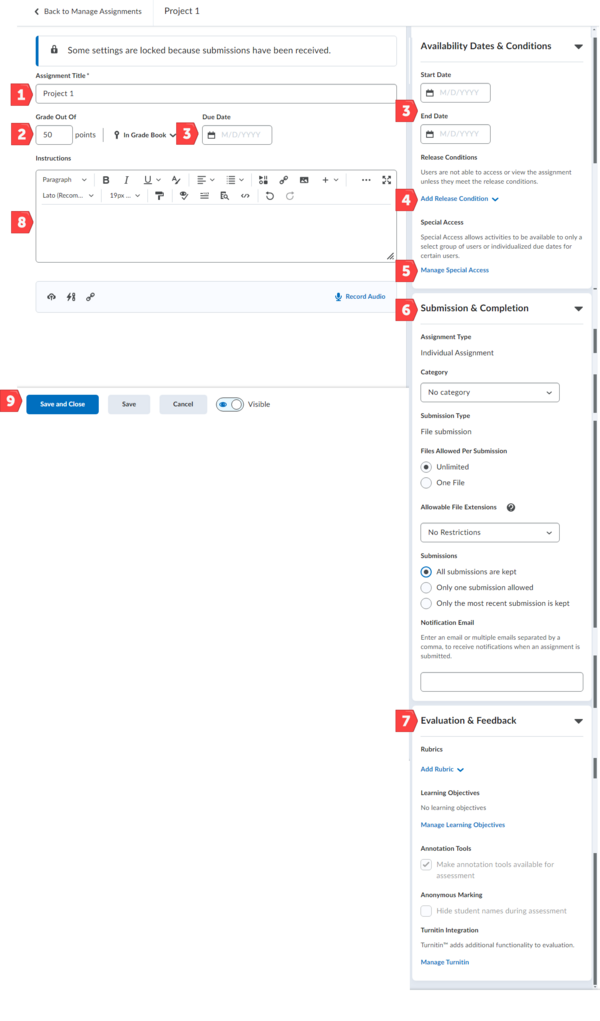Add a Brightspace Assignment folder
Jump to navigation
Jump to search
Instructors can add a Brightspace Assignment folder to their Brightspace course that can be used to gather and evaluate student work and track the completion of on-paper and in-person activities.
Add a new folder
- From your course homepage, select Assignments from the Assessments menu.
- Select the New Assignment button. This will open the New Assignment view.
- Enter the assignment Name (Fig 1.1) and any Instructions (Fig 1.8).
- Select a folder type (Fig 1.6) and evaluation options (Fig 1.7) for the assignment. Set a due date (Fig 1.3), availability dates (Fig 1.3), and conditions (Fig 1.4) as needed. Find descriptions of these options here. Instructions for configuring these options are listed below.
- Select the Save and Close (Fig 1.9) button to save your assignment folder and return to your list of assignments.
Choose a folder type
When creating or editing a folder, select Submission & Completion (Fig 1.6) to expand the list of settings.
Assignment type
- Under Assignment Type, select either Individual Assignment or Group Assignment.
- If Group Assignment is selected, choose a Group Category (e.g., Project Groups, Lab Teams) that you created previously. Learn more about creating groups in your Brightspace courses.
Submission type
File
- Under Submission Type, select File submission.
- Under Files Allowed Per Submission, select Unlimited or One File. Choose Unlimited if the assignment requires students to upload more than one file.
- If restricting the types of files that can be submitted, select a preset restriction or Custom File Types under Allowable File Extensions. If you select Custom File Types, enter the allowable file types manually. Find more information about handling file types here.
- Under Submissions, choose whether to allow one or multiple submissions (e.g., attempts, drafts) of the same assignment. Learn more about supporting multiple submissions.
Text
- Under Submission Type, select Text submission.
- Under Submissions, choose whether to allow one or multiple submissions (e.g., attempts, drafts) of the same assignment.
On paper
- Under Submission Type, select On paper submission.
- Under Marked as completed, select whether you want the assignment marked as completed by the student manually, automatically when you publish your evaluation, or automatically on the due date.
Observed in person
- Under Submission Type, select Observed in person.
- Under Marked as completed, select whether you want the assignment marked as completed by the student manually, automatically when you publish your evaluation, or automatically on the due date.
Choose evaluation options (Fig 1.2)
Ungraded
- Leave the default Ungraded setting in the Grade Out Of field.
- If the Grade Out Of field has changed to a points entry box, select In Grade Book and select Reset to Ungraded.
Graded (not in grade book)
- Enter the point total in the Grade Out Of field.
- Select Not In Grade Book in the next field.
Graded (in grade book)
- Enter the point total in the Grade Out Of field.
- Select In Grade Book in the next field.
- Select Edit or Link to Existing to add a new grade item or connect the assignment to an existing item.
Set dates and conditions (Fig 1.3)
Dates
- Select the Due Date field and enter the date using the calendar function.
- To set the dates the assignment is available to the students, click the arrow after Availability & Conditions and enter the Start Date and End Date by clicking in the fields and using the calendar function.
Release Conditions
- Release conditions can be added by either creating a new condition or connecting an existing condition.
Special Access
- Special access can be granted to students for access to the assignment (in the same way as in quizzes).
Evaluation & feedback (Fig 1.7)
- Clicking the arrow to the right of Evaluation & Feedback let's you set up how you get feedback to the students. You can optionally attach a rubric to the assignment. (More information on Brightspace rubrics is available at Brightspace Rubrics.)
- Checking the box under Annotation Tools turns on the annotation tools within Assignments. (For more information, see Using annotation to give feedback. You can also state whether peer reviews are anonymous under Anonymous Marking. (Fig 5)
- You can Manage Turnitin - an optional plagiarism detection tool.
More wiki articles
- Add Turnitin to Brightspace assignments
- Submit assignments in Brightspace
- Brightspace Assignments
- Add a Brightspace Assignment folder
- Add feedback to Assignment Submission Folders
- Add feedback to a student's Brightspace assignment submission
- Category:Brightspace Assignments Teacher
